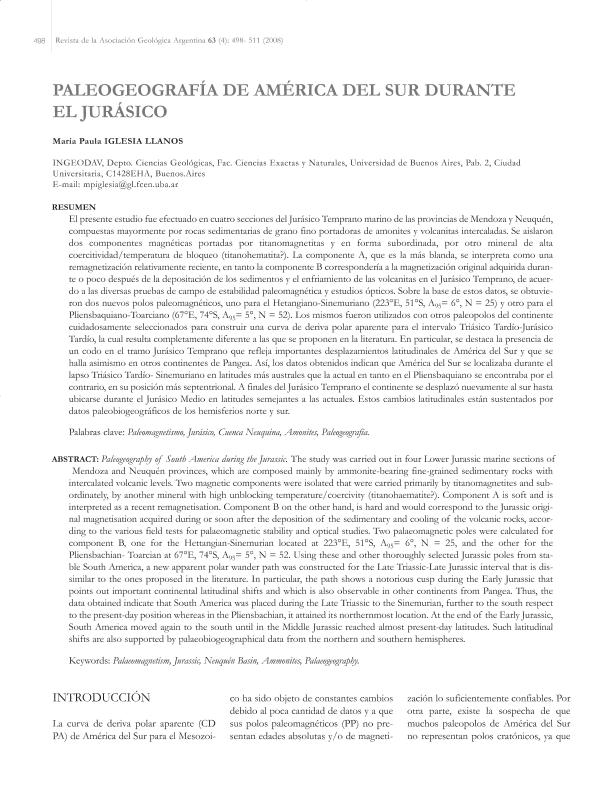Artículo
El presente estudio fue efectuado en cuatro secciones del Jurásico Temprano marino de las provincias de Mendoza y Neuquén, compuestas mayormente por rocas sedimentarias de grano fino portadoras de amonites y volcanitas intercaladas. Se aislaron dos componentes magnéticas portadas por titanomagnetitas y en forma subordinada, por otro mineral de alta coercitividad/temperatura de bloqueo (titanohematita?). La componente A, que es la más blanda, se interpreta como una remagnetización relativamente reciente, en tanto la componente B correspondería a la magnetización original adquirida durante o poco después de la depositación de los sedimentos y el enfriamiento de las volcanitas en el Jurásico Temprano, de acuerdo a las diversas pruebas de campo de estabilidad paleomagnética y estudios ópticos. Sobre la base de estos datos, se obtuvieron dos nuevos polos paleomagnéticos, uno para el Hetangiano-Sinemuriano (223°E, 51°S, A95= 6°, N = 25) y otro para el Pliensbaquiano-Toarciano (67°E, 74°S, A95= 5°, N = 52). Los mismos fueron utilizados con otros paleopolos del continente cuidadosamente seleccionados para construir una curva de deriva polar aparente para el intervalo Triásico Tardío-Jurásico Tardío, la cual resulta completamente diferente a las que se proponen en la literatura. En particular, se destaca la presencia de un codo en el tramo Jurásico Temprano que refleja importantes desplazamientos latitudinales de América del Sur y que se halla asimismo en otros continentes de Pangea. Así, los datos obtenidos indican que América del Sur se localizaba durante el lapso Triásico Tardío- Sinemuriano en latitudes más australes que la actual en tanto en el Pliensbaquiano se encontraba por el contrario, en su posición más septentrional. A finales del Jurásico Temprano el continente se desplazó nuevamente al sur hasta ubicarse durante el Jurásico Medio en latitudes semejantes a las actuales. Estos cambios latitudinales están sustentados por datos paleobiogeográficos de los hemisferios norte y sur. The study was carried out in four Lower Jurassic marine sections of Mendoza and Neuquén provinces, which are composed mainly by ammonite-bearing fine-grained sedimentary rocks with intercalated volcanic levels. Two magnetic components were isolated that were carried primarily by titanomagnetites and subordinately, by another mineral with high unblocking temperature/coercivity (titanohaematite?). Component A is soft and is interpreted as a recent remagnetisation. Component B on the other hand, is hard and would correspond to the Jurassic original magnetisation acquired during or soon after the deposition of the sedimentary and cooling of the volcanic rocks, according to the various field tests for palaeomagnetic stability and optical studies. Two palaeomagnetic poles were calculated for component B, one for the Hettangian-Sinemurian located at 223°E, 51°S, A95= 6°, N = 25, and the other for the Pliensbachian- Toarcian at 67°E, 74°S, A95= 5°, N = 52. Using these and other thoroughly selected Jurassic poles from stable South America, a new apparent polar wander path was constructed for the Late Triassic-Late Jurassic interval that is dissimilar to the ones proposed in the literature. In particular, the path shows a notorious cusp during the Early Jurassic that points out important continental latitudinal shifts and which is also observable in other continents from Pangea. Thus, the data obtained indicate that South America was placed during the Late Triassic to the Sinemurian, further to the south respect to the present-day position whereas in the Pliensbachian, it attained its northernmost location. At the end of the Early Jurassic, South America moved again to the south until in the Middle Jurassic reached almost present-day latitudes. Such latitudinal shifts are also supported by palaeobiogeographical data from the northern and southern hemispheres.
Paleogeografía de América del Sur durante el Jurásico
Título:
Paleogeography of South America during the Jurassic
Fecha de publicación:
12/2008
Editorial:
Asociación Geoógica Argentina
Revista:
Revista de la Asociación Geológica Argentina
ISSN:
0004-4822
Idioma:
Español
Tipo de recurso:
Artículo publicado
Clasificación temática:
Resumen
Palabras clave:
Paleomagnetismo
,
Cuenca Neuquina
,
Jurasico
,
Amonites
,
Paleogeografía
Archivos asociados
Licencia
Identificadores
Colecciones
Articulos(IGEBA)
Articulos de INSTITUTO DE GEOCIENCIAS BASICAS, APLICADAS Y AMBIENTALES DE BS. AS
Articulos de INSTITUTO DE GEOCIENCIAS BASICAS, APLICADAS Y AMBIENTALES DE BS. AS
Citación
Iglesia Llanos, Maria Paula; Paleogeografía de América del Sur durante el Jurásico; Asociación Geoógica Argentina; Revista de la Asociación Geológica Argentina; 63; 4; 12-2008; 498-511
Compartir




